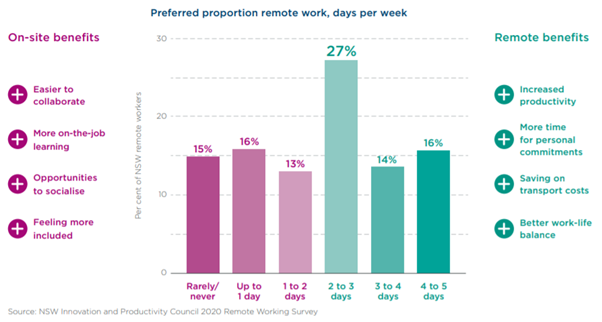History shows that the recovery period following economic downturns can often accelerate the transition of industries or magnify trends that were already occurring in the economy. In this blog, Keenan explores one of the key trends set to continue post-COVID – remote working.
One of the more common questions we have been asked over the last year is how the COVID pandemic lockdowns will impact journey to work patterns in the future. With many office workers in capital cities having prolonged experience of working from home recently, maybe the forecast ‘work anywhere’ model envisioned at the onset of the internet will finally come to fruition. Certainly, many companies have enacted more flexible policies to support this as the pandemic continued.
What happened during COVID?
At the start of the pandemic last year, governments in Australia implemented strict stay at home policies for non-essential workers. This saw a plummet in work trips across major cities and an increase in time spent at home. Using google mobility data, we saw that trips to Melbourne’s CBD (City of Melbourne LGA) fell by 66% compared to pre-COVID, Sydney fell by 61%. On the flip side, the time spent at home increased substantially for many inner-city suburbs within easy commuting distance to the CBD. The chart below presents the LGAs in Australia where time at home increased by more than 25% (average of 4 hours per day). Aside from all being in Greater Sydney or Greater Melbourne, the other common factor for these LGAs is industry of employment. In 14 out of 20, the top industry of employment for residents is Professional, Scientific and Technical Services (NIEIR, 2021). In the other 6, this industry is either the 2nd or 3rd largest employer.
By the end of the year, many LGAs in Australia were back to normal. However, the majority of inner-suburban areas in Sydney and Melbourne were still experiencing residents being at home by 10-15% more than pre-COVID levels (extra 1.5-3 hrs a day or 1-2 days per week). The February 2021 ABS Household Impacts of COVID-19 Survey showed two in five people with a job (41 per cent) worked from home at least once a week in February 2021, compared with 24 per cent at least once a week before March 2020.
Which industries could support more remote working going forward?
It is quite obvious that office based work has the greatest potential to be adapted to an at home or remote working environment. The data we just showed on LGAs backs this up. A study by McKinsey in the US demonstrates there is potential for other industries, but finance, management, professional services and IT have the greatest ability to be performed remotely with minimal productivity loss.
What are worker's preferences regarding remote working?
At the end of 2020, the NSW Government published the results of a survey of people working remotely. The report highlighted that 67% expected to work from home more after the COVID pandemic is over. This of course relies on business owners supporting more flexible work patterns.
Only 16% of workers in the survey stated they would like to work 4-5 days a week remotely. The most common response (27%) was a hybrid model of 2-3 days a week. Respondents were balancing off the benefits of working from home (e.g. better work life balance, transport savings) with those of the office environment (e.g. socialising, collaboration, and knowledge sharing).

This means connections to an office will still be important for most. However, even if 5-10% of the workforce opt to work fully remote and are supported to do so (similar to the policy adopted by companies like Atlassian last year), the changes could be profound.
Perhaps not surprisingly, female employees are more likely to express interest in working from home more. The February 2021 ABS Survey showed that although women were only slightly more likely to be working from home (49% compared to 48%), they were more likely (17%) than employed men (11%) to want to increase the amount of work done from home in the future. Flexible work arrangements would appear to help support the ongoing participation of many women, and men, juggling work and family commitments. However, some have raised concerns how this might disadvantage career progression for female employees due to potential less time in the office meaning they are less visible to management and excluded from important incidental conversations.
Which locations might see growth based on past trends?
Some LGAs in Australia are likely to be affected more than others if the working from home trend becomes a longer-term reality. In 2016, the City of Brisbane was home to 7% of all Australia's employed residents who were working in knowledge intensive business services (finance, IT, professional and technical) and also working from home at the time of the Census. This is no surprise given that the LGA is the largest in the country by number of residents. Many other large LGAs are represented, but some are quite small. Bayside (Victoria) and Ku-ring-gai (NSW) are highly affluent areas supporting less than 60,000 employed residents in 2016. However, they were both in the top 15 in terms of residents employed in home-based knowledge intensive business areas.
If we look at the number of an LGA's employed residents in home based knowledge intensive business areas as a share of its total employed resident base in 2016, it draws an interesting picture. The top 15 LGAs are really a who's who of the richest locations in Australia (8 out of Australia's 10 most socio-economically advantaged LGAs are listed) or major luxury lifestyle destinations (e.g. Noosa, Byron). This perhaps highlights that prior to COVID, working from home was really dominated by wealthy business owners/entrepreneurs or those senior enough to demand flexible working conditions (for example, 69% in Mosman were owner/managers). (Want to see where your LGA stands, explore this interactive map)
Going forward, the distribution is likely to be more evenly spread due to increasing flexibility in company policies (responding to employee demands). In addition, there appears to be a rise in working from home in public sector office-based roles. Historically, public administration workforces appeared to lag behind professional business services, but according to a Roy Morgan poll this industry was one of the largest adopters of remote working during the pandemic.
Questions still remain as to how much the trend will impact capital cities or regions in states that have been far less impacted by COVID. For example, in the City of Adelaide and City of Perth work trips were only down by 5% by October 2020 compared to >30% for Sydney and Melbourne. According to the February ABS Survey, only 17% of South Australian respondents said they were mostly working from home, compared to 26% for NSW.
Implications for local government
Councils may need to consider adjustments to planning if the working from home trend becomes a longer-term reality. Some ideas to consider include:
- Supporting establishment of co-working or “Work Near Home” suburban shared workspace facilities in high amenity retail/commercial hubs
- Looking for opportunities to repurpose vacant or underutilised premises and/or ensure new developments provide enough smaller adaptive commercial space
- Exploring surveying local professional services home based businesses/employees to investigate scale and needs of this market
- Have a plan to manage a potential increase of waste in suburban areas (COVID-19 reversed a long-term trend, increasing household waste by 20% during 2020)
- Identifying if transport infrastructure needs to be adapted for potentially lower work trips, but increased weekday local suburban movements
- Taking a look at your own council's work policies and ensure they support flexibility, but do not disadvantage anyone who takes up the opportunity for remote working over someone who doesn’t.
If you are keen to understand how your economy has changed in recent years, or how it might look in the future, please get in touch with us. We have recently delivered a number of 'health checks' for local governments across Australia including Greater Geelong, Northern Beaches and Rockhampton. These reports have been crucial in helping councils with long term economic planning and strategy development.










